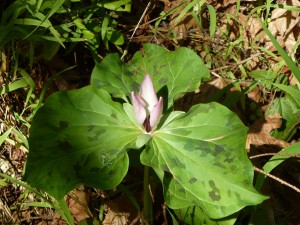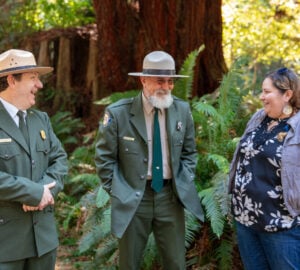
Have you ever seen this stunning flower in the redwood forest? It is a Giant Wake Robin, or Trillium chloropetalum, and was recently seen blooming in the Santa Cruz Mountains by our staff and our colleagues from POST. The petals range from purple to red to orange and sometime appear greenish, the reason the species is named chloropetalum or “green petal”. It is known for its three large broad leaves that together form a large triangle.
It is closely related to the Western Wake Robin, Trillium ovatum, which is also found in the coast redwood forest. Both of these plants have toxic underground stems and cause vomiting if eaten, so don’t toss them into your next foraged salad!
How to best tell these two species apart? The flower of the Giant Wake Robin grows directly from the stem where the leaves also connect. In contrast, the Western Wake Robin’s flower is elevated up on a portion of stem above the leaves. Did you know that the stem that holds up a flower in any plant is called a peduncle? I love this word…just further evidence that my nerdy botanical tendencies are showing.
Learn more about the plants of the redwoods by checking out the botanical research studies the League funds.








